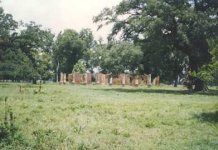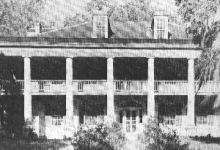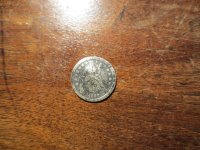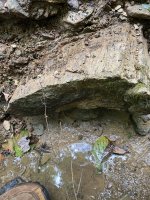- Jan 6, 2006
- 20,846
- 2,532
- 🏆 Honorable Mentions:
- 1
- Detector(s) used
- Garrett AT Pro, Ace 250 & Ace 400
- Primary Interest:
- All Treasure Hunting
Resurrecting A Buried Southern Treasure In The Town of Raymond, Mississippi
As a resident of Clinton, Mississippi, and a history buff, I have a growing love and appreciation for our sister city of Raymond, just seven miles to our south. Over the past several years, Raymondites have rallied together like their ancestors did during the turbulent years of the American Civil War. This time, however, the purpose of their rally isn't to defend their property against an attacking army, but to preserve a Vicksburg campaign battlefield located on the edge of town that will surely meet destruction if steps are not taken to save it.
The love of the historic heritage of this community has spread beyond the borders of this tiny town and now others are joining in the noble cause of preservation.
My personal appreciation and preservation efforts of Civil War period sites have led me to actively look for artifacts lost by these Union and Confederate soldiers who fought in and around our local area. Artifacts can play an important role in interpreting a site or they can even tell us more about the soldiers themselves. Nothing could have prepared me for the artifact discovery I was soon to make and the great adventure that would follow which shed some new light on Raymond's rich Civil War past.
In June 1993, my friends and I were taking advantage of a beautiful, warm Saturday afternoon by searching for Civil War period artifacts on private property in Raymond. We soon began to find all kinds of relics from the war including minie balls, buttons, and uniform items. Among the many relics recovered was a brass tip to a soldier's bowie knife. Commonly called a "finial" by collectors, this brass piece was part of the scabbard harness that held the knife in its sheath. What made the find even ?more special was the fact that the soldier who once owned the knife had scratched his name, company, and regiment into the brass facing of the finial. This. 130 year old inscription read: Ripley H. Conrad, Delta Rifles, 4th Louisiana Volunteers! The inscription had provided me with enough information to go to the state archives and research all I could about the mysterious soldier whom I would soon refer to as "my soldier" and his military unit.
During our relic hunting adventure that Saturday afternoon, we assumed that because we were finding Civil War period artifacts they were linked to the battle of Raymond or the Vicksburg campaign defenses. Amazingly, the research that followed proved to us that the artifacts we were finding at the site were lost at a different time in the war, more than likely in 1864, and expanded our understanding of Civil War Raymond beyond the context of the Vicksburg campaign and the battle of Raymond.
After six years of research, thousands of miles of road travel, phone calls, letters, and a lot of luck, the amazing life and lineage of "my soldier" came to life.
Ripley Holmes Conrad was born December 27, 1841, into a life of privilege at The Cottage plantation near Baton Rouge, Louisiana. Ripley's rich ancestry can be traced all the way back to 1753, when his great-grandfather came to colonial Virginia from Germany aboard the sailing ship, The Eastern Branch After arriving in America, the elder Conrad established tan yards, hop yards, and vineyards. He became very wealthy during the American Revolution by having the only tan yard in the western colonies and selling leather goods to the Continental Line army. He later built a school called The Winchester Academy to educate young men. Among the most famous of its students to be educated at the academy was a young man named David Holmes who grew up to become the first governor of Mississippi.
Ripley's grandfather moved from Virginia to Natchez and later became a planter on Bayou Teche south of present day Lafayette, Louisiana. One of his children, Charles Magill Conrad (Ripley's uncle) became a U.S. senator and later the Secretary of War under President Millard Fillmore. Interestingly, Charles Magill married Mary Angela Lewis, who was the only grand-niece of George and Martha Washington. Historic artifacts and family papers of the Washington's stayed in the family until 1894, when they were donated to the Mount Vernon collection.
Ripley Conrad was one of nine children born to Frederick and Frances Conrad. In following with his family's successes, his father ran a cotton and sugar cane planting operation, had a successful state political career, and had a fortune in horse racing stock. By 1860, Frederick Conrad's net worth was estimated at around 3 million dollars! Among the visitors entertained at their Cottage plantation home were such famous historical figures as: Henry Clay, Judah P. Benjamin, U.S. presidents Andrew Jackson and Zachary Taylor, as well as French general Lafayette who landed at Conrad Point on his second visit to Louisiana.

Ruins of The Cottage Plantation near Baton Rouge
When hostilities erupted resulting in the secession of states, the Conrad's loyalties were cast with Louisiana. Ripley Conrad was the only one of Frederick's children to join the Confederate army in April of 1862. He initially joined the Delta Rifle Company of the Fourth Louisiana regiment. It was made up of men from the cotton rich areas from Baton Rouge to New Orleans. They were distinguished fighters who saw action in major campaigns of the war including Corinth and Shiloh. Because of high casualties suffered by the unit the Fourth Louisiana was reorganized by the time Ripley Conrad joined the ranks. He was sent to Camp Moore in Tangipahoa, Louisiana to await his orders. While there, he was mustered into a partisan ranger unit organized by Colonel James H. Wingfield known as the Ninth Louisiana Battalion of Partisan Rangers. Ripley was given a staff officer position as Adjutant. The only action that Conrad participated in was the Battle of Baton Rouge in August of 1862. Because of his position, he would have most likely avoided any direct contact with the enemy.
On September 26, 1862, Ripley Conrad was dead, more than likely due to an illness. Malaria and yellow fever were rampant in the area during that time. He was buried at St. Joseph's churchyard in Baton Rouge. It is believed that during the time of his death, if not before, his bowie knife was passed on to another member of his unit. This was a common practice since the need for weapons and personal gear was desperately needed among the living.
From January 28th till February 5th, 1864, the Ninth Louisiana was encamped in Raymond as part of Confederate General Wirt Adams' 800-member cavalry force directed to thwart the advance of Federal troops crossing the Big Black River. Since Ripley Conrad never appeared to be anywhere near Raymond during his life, it makes sense that his knife was lost a year and a half later in Raymond by another member of his unit.
My research efforts came full circle on January 11, 1997. On that date, following a formal ceremony complete with Civil War period re-enactors, I was able to honor the final resting place of Ripley Conrad by erecting a new stone grave marker at St. Joseph Catholic cemetery in Baton Rouge.
For me to have been a part in the preservation of the life and family legacy of Ripley Holmes Conrad has been a great privilege and responsibility. It almost seems unbelievable that so much information about a Civil War character could be deemed from a simple relic found in the ground in Raymond, Mississippi. I believe such history as this that was brought to light after being buried for so many years should be looked upon as a bridge of truth about our southern culture not to be divisive or misunderstood but to be seen as another glimmer of understanding of past events that make up the rich heritage of our community in which we live.
For more information on Raymond, the battles surrounding the campaign for Vicksburg, and select artifacts recovered from campaign sites, please view my web site at: http://www2.netdoor.com/~phaethon.
A good read by Tom Hughes found on the www; unfortunately his website is no good.
As a resident of Clinton, Mississippi, and a history buff, I have a growing love and appreciation for our sister city of Raymond, just seven miles to our south. Over the past several years, Raymondites have rallied together like their ancestors did during the turbulent years of the American Civil War. This time, however, the purpose of their rally isn't to defend their property against an attacking army, but to preserve a Vicksburg campaign battlefield located on the edge of town that will surely meet destruction if steps are not taken to save it.
The love of the historic heritage of this community has spread beyond the borders of this tiny town and now others are joining in the noble cause of preservation.
My personal appreciation and preservation efforts of Civil War period sites have led me to actively look for artifacts lost by these Union and Confederate soldiers who fought in and around our local area. Artifacts can play an important role in interpreting a site or they can even tell us more about the soldiers themselves. Nothing could have prepared me for the artifact discovery I was soon to make and the great adventure that would follow which shed some new light on Raymond's rich Civil War past.
In June 1993, my friends and I were taking advantage of a beautiful, warm Saturday afternoon by searching for Civil War period artifacts on private property in Raymond. We soon began to find all kinds of relics from the war including minie balls, buttons, and uniform items. Among the many relics recovered was a brass tip to a soldier's bowie knife. Commonly called a "finial" by collectors, this brass piece was part of the scabbard harness that held the knife in its sheath. What made the find even ?more special was the fact that the soldier who once owned the knife had scratched his name, company, and regiment into the brass facing of the finial. This. 130 year old inscription read: Ripley H. Conrad, Delta Rifles, 4th Louisiana Volunteers! The inscription had provided me with enough information to go to the state archives and research all I could about the mysterious soldier whom I would soon refer to as "my soldier" and his military unit.
During our relic hunting adventure that Saturday afternoon, we assumed that because we were finding Civil War period artifacts they were linked to the battle of Raymond or the Vicksburg campaign defenses. Amazingly, the research that followed proved to us that the artifacts we were finding at the site were lost at a different time in the war, more than likely in 1864, and expanded our understanding of Civil War Raymond beyond the context of the Vicksburg campaign and the battle of Raymond.
After six years of research, thousands of miles of road travel, phone calls, letters, and a lot of luck, the amazing life and lineage of "my soldier" came to life.
Ripley Holmes Conrad was born December 27, 1841, into a life of privilege at The Cottage plantation near Baton Rouge, Louisiana. Ripley's rich ancestry can be traced all the way back to 1753, when his great-grandfather came to colonial Virginia from Germany aboard the sailing ship, The Eastern Branch After arriving in America, the elder Conrad established tan yards, hop yards, and vineyards. He became very wealthy during the American Revolution by having the only tan yard in the western colonies and selling leather goods to the Continental Line army. He later built a school called The Winchester Academy to educate young men. Among the most famous of its students to be educated at the academy was a young man named David Holmes who grew up to become the first governor of Mississippi.
Ripley's grandfather moved from Virginia to Natchez and later became a planter on Bayou Teche south of present day Lafayette, Louisiana. One of his children, Charles Magill Conrad (Ripley's uncle) became a U.S. senator and later the Secretary of War under President Millard Fillmore. Interestingly, Charles Magill married Mary Angela Lewis, who was the only grand-niece of George and Martha Washington. Historic artifacts and family papers of the Washington's stayed in the family until 1894, when they were donated to the Mount Vernon collection.
Ripley Conrad was one of nine children born to Frederick and Frances Conrad. In following with his family's successes, his father ran a cotton and sugar cane planting operation, had a successful state political career, and had a fortune in horse racing stock. By 1860, Frederick Conrad's net worth was estimated at around 3 million dollars! Among the visitors entertained at their Cottage plantation home were such famous historical figures as: Henry Clay, Judah P. Benjamin, U.S. presidents Andrew Jackson and Zachary Taylor, as well as French general Lafayette who landed at Conrad Point on his second visit to Louisiana.

Ruins of The Cottage Plantation near Baton Rouge
When hostilities erupted resulting in the secession of states, the Conrad's loyalties were cast with Louisiana. Ripley Conrad was the only one of Frederick's children to join the Confederate army in April of 1862. He initially joined the Delta Rifle Company of the Fourth Louisiana regiment. It was made up of men from the cotton rich areas from Baton Rouge to New Orleans. They were distinguished fighters who saw action in major campaigns of the war including Corinth and Shiloh. Because of high casualties suffered by the unit the Fourth Louisiana was reorganized by the time Ripley Conrad joined the ranks. He was sent to Camp Moore in Tangipahoa, Louisiana to await his orders. While there, he was mustered into a partisan ranger unit organized by Colonel James H. Wingfield known as the Ninth Louisiana Battalion of Partisan Rangers. Ripley was given a staff officer position as Adjutant. The only action that Conrad participated in was the Battle of Baton Rouge in August of 1862. Because of his position, he would have most likely avoided any direct contact with the enemy.
On September 26, 1862, Ripley Conrad was dead, more than likely due to an illness. Malaria and yellow fever were rampant in the area during that time. He was buried at St. Joseph's churchyard in Baton Rouge. It is believed that during the time of his death, if not before, his bowie knife was passed on to another member of his unit. This was a common practice since the need for weapons and personal gear was desperately needed among the living.
From January 28th till February 5th, 1864, the Ninth Louisiana was encamped in Raymond as part of Confederate General Wirt Adams' 800-member cavalry force directed to thwart the advance of Federal troops crossing the Big Black River. Since Ripley Conrad never appeared to be anywhere near Raymond during his life, it makes sense that his knife was lost a year and a half later in Raymond by another member of his unit.
My research efforts came full circle on January 11, 1997. On that date, following a formal ceremony complete with Civil War period re-enactors, I was able to honor the final resting place of Ripley Conrad by erecting a new stone grave marker at St. Joseph Catholic cemetery in Baton Rouge.
For me to have been a part in the preservation of the life and family legacy of Ripley Holmes Conrad has been a great privilege and responsibility. It almost seems unbelievable that so much information about a Civil War character could be deemed from a simple relic found in the ground in Raymond, Mississippi. I believe such history as this that was brought to light after being buried for so many years should be looked upon as a bridge of truth about our southern culture not to be divisive or misunderstood but to be seen as another glimmer of understanding of past events that make up the rich heritage of our community in which we live.
For more information on Raymond, the battles surrounding the campaign for Vicksburg, and select artifacts recovered from campaign sites, please view my web site at: http://www2.netdoor.com/~phaethon.
A good read by Tom Hughes found on the www; unfortunately his website is no good.






